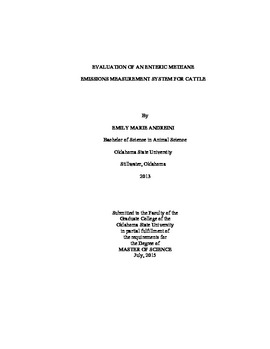| dc.description.abstract | Growing concern about climate change and sustainability has increased societal pressures toward livestock production to quantify and reduce its environmental impact. Through the process of enteric fermentation, ruminant animals produce methane (CH4), a potent greenhouse gas (GHG). To improve emission inventories and evaluate mitigation techniques, several methods of measuring emissions from ruminants have been developed. The present study evaluated a ventilated head box system capable of measuring CH4 and carbon dioxide (CO2) emissions, and oxygen (O2) consumption from cattle. Six Holstein heifers were used to measure CH4 and CO2 emissions and O2 consumption from two ad libitum intake measurement periods and one measurement period with intake restricted to 2% of body weight on a dry matter basis. As a measure of comfort in the head box system, all cattle were assessed for lying time, and respiration rates and THI were evaluated for thermal comfort. Methane and CO2 emissions during the restricted intake period were significantly lower (P < 0.0001) than the ad libitum periods. Daily CH4 emission rates per animal were reported as 235.0 � 6.19 L/day, 228.3 � 6.18 L/day, and 193.2 � 8.88 L/day for the first and second ad libitum and feed restriction periods, respectively. Carbon dioxide emission rates were reported as 3627.5 � 90.72 L/day, 3632.4 � 90.47, and 3184.0 � 104.79 L/day for the first and second ad libitum and feed restriction periods, respectively. Oxygen consumption rates were reported as 3390.59 � 99.77 L/day, 3453.90 � 99.57 L/day, and 3001.81 � 111.36 L/day for the first and second ad libitum and feed restriction periods, respectively. Lying time was similar to behaviors reported in previous literature and averaged 779.17 � 31.19 min/day, 768.79 � 31.19 min/day, and 842.78 � 31.19 min/day for the first and second ad libitum and restriction periods, respectively. There was no difference (P > 0.05) in THI and respiration rate across all measurement periods, and THI and respiration rate were positively correlated (R2 = 0.381; P < 0.0001). The head box system provides an accurate method of measuring emissions from cattle and can provide information about daily variations and peaks in emissions. | |
